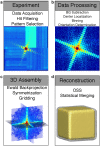Single-shot 3D coherent diffractive imaging of core-shell nanoparticles with elemental specificity
- PMID: 29844398
- PMCID: PMC5974371
- DOI: 10.1038/s41598-018-26182-1
Single-shot 3D coherent diffractive imaging of core-shell nanoparticles with elemental specificity
Abstract
We report 3D coherent diffractive imaging (CDI) of Au/Pd core-shell nanoparticles with 6.1 nm spatial resolution with elemental specificity. We measured single-shot diffraction patterns of the nanoparticles using intense x-ray free electron laser pulses. By exploiting the curvature of the Ewald sphere and the symmetry of the nanoparticle, we reconstructed the 3D electron density of 34 core-shell structures from these diffraction patterns. To extract 3D structural information beyond the diffraction signal, we implemented a super-resolution technique by taking advantage of CDI's quantitative reconstruction capabilities. We used high-resolution model fitting to determine the Au core size and the Pd shell thickness to be 65.0 ± 1.0 nm and 4.0 ± 0.5 nm, respectively. We also identified the 3D elemental distribution inside the nanoparticles with an accuracy of 3%. To further examine the model fitting procedure, we simulated noisy diffraction patterns from a Au/Pd core-shell model and a solid Au model and confirmed the validity of the method. We anticipate this super-resolution CDI method can be generally used for quantitative 3D imaging of symmetrical nanostructures with elemental specificity.
Conflict of interest statement
The authors declare no competing interests.
Figures





References
-
- Dabbousi BO, et al. (CdSe)ZnS Core−Shell Quantum Dots: Synthesis and Characterization of a Size Series of Highly Luminescent Nanocrystallites. The Journal of Physical Chemistry B. 1997;101:9463–9475. doi: 10.1021/jp971091y. - DOI
Publication types
LinkOut - more resources
Full Text Sources
Other Literature Sources

